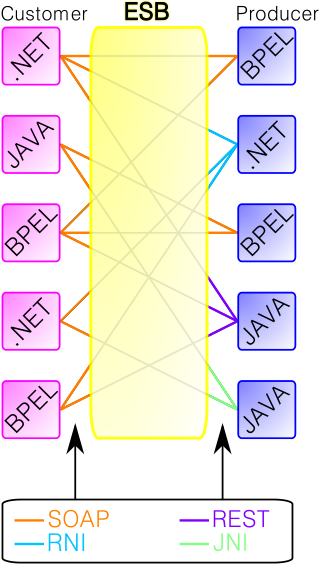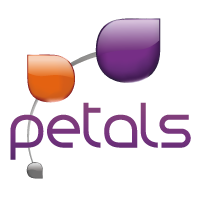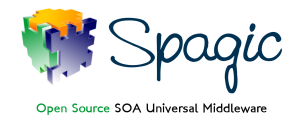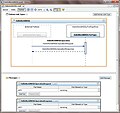A web service (WS) is either:

An enterprise service bus (ESB) implements a communication system between mutually interacting software applications in a service-oriented architecture (SOA). It represents a software architecture for distributed computing, and is a special variant of the more general client-server model, wherein any application may behave as server or client. ESB promotes agility and flexibility with regard to high-level protocol communication between applications. Its primary use is in enterprise application integration (EAI) of heterogeneous and complex service landscapes.
Java Business Integration (JBI) is a specification developed under the Java Community Process (JCP) for an approach to implementing a service-oriented architecture (SOA). The JCP reference is JSR 208 for JBI 1.0 and JSR 312 for JBI 2.0. JSR 312 was removed from the JCP balloting process on 17 Dec, 2010 by the submitters without being accepted.
Mule is a lightweight enterprise service bus (ESB) and integration framework provided by MuleSoft. It has a Java-based platform and can also act as broker for interactions between other platforms such as .NET using web services or sockets.
Oracle Fusion Middleware consists of several software products from Oracle Corporation. FMW spans multiple services, including Java EE and developer tools, integration services, business intelligence, collaboration, and content management. FMW depends on open standards such as BPEL, SOAP, XML and JMS.
IBM App Connect Enterprise (abbreviated as IBM ACE, formerly known as IBM Integration Bus, WebSphere Message Broker, WebSphere Business Integration Message Broker, WebSphere MQSeries Integrator and started life as MQSeries Systems Integrator. App Connect IBM's integration software offering, allowing business information to flow between disparate applications across multiple hardware and software platforms. Rules can be applied to the data flowing through user-authored integrations to route and transform the information. The product can be used as an Enterprise Service Bus supplying a communication channel between applications and services in a service-oriented architecture. App Connect from V11 supports container native deployments with highly optimised container start-up times.
Oracle Enterprise Service Bus, a fundamental component of Oracle's Services-Oriented Architecture suite of products, provides integration of data and enterprise applications within an organisation and their connected enterprises.
Apache Camel is an open source framework for message-oriented middleware with a rule-based routing and mediation engine that provides a Java object-based implementation of the Enterprise Integration Patterns using an application programming interface to configure routing and mediation rules.
Apache CXF is an open source software project developing a Web services framework. It originated as the combination of Celtix developed by IONA Technologies and XFire developed by a team hosted at the now defunct host CodeHaus in 2006. These two projects were combined at the Apache Software Foundation. The name "CXF" was derived by combining "Celtix" and "XFire".

Apache ODE is a software coded in Java as a workflow engine to manage business processes which have been expressed in the Web Services Business Process Execution Language (WS-BPEL) via a website. It was made by the Apache Software Foundation and released in a stable format on March 23, 2018. The software principally communicates with one or more Web services, sending and receiving messages, manipulating data and handling exceptions (errors) as defined by any given process. The engine is capable of running both long and short living processes to coordinate all the services that make up a service or application (orchestration).
Service Component Architecture (SCA) is a software technology designed to provide a model for applications that follow service-oriented architecture principles. The technology, created by major software vendors, including IBM, Oracle Corporation and TIBCO Software, encompasses a wide range of technologies and as such is specified in independent specifications to maintain programming language and application environment neutrality. Many times it uses an enterprise service bus (ESB).
JBoss Tools is a set of Eclipse plugins and features designed to help JBoss and JavaEE developers develop applications. It is an umbrella project for the JBoss developed plugins that will make it into JBoss Developer Studio.

Petals ESB is an open-source ESB developed by Linagora. It is a tool for implementing a service-oriented architecture (SOA). It is standard, modular, and physically distributed, to adapt to large-scale infrastructures.
JBoss Developer Studio (JBDS) was a development environment created and developed by JBoss and Exadel.

Spagic is a Universal Middleware, characterized by an innovative approach to the governance and realization of SOA solutions, which are highly modular and configurable around an OSGi kernel.
Java Composite Application Platform Suite (Java CAPS) is a standards-based enterprise service bus software suite from Oracle Corporation. The suite has several components that help to integrate existing applications and deliver new business services in a service-oriented architecture environment. It is a Java EE compliant platform and provides application-to-application integration, business-to-business integration, business process management along with integrated human workflow, an Enterprise Information Portal, extract transform and load (ETL), business activity monitoring and composite application development.
IBM WebSphere Service Registry and Repository (WSRR) is a service registry for use in a Service-oriented architecture.
The JBoss Enterprise SOA Platform is free software/open-source Java EE-based service-oriented architecture (SOA) software. The JBoss Enterprise SOA Platform is part of the JBoss Enterprise Middleware portfolio of software. The JBoss Enterprise SOA Platform enables enterprises to integrate services, handle business events, and automate business processes, linking IT resources, data, services and applications. Because it is Java-based, the JBoss application server operates cross-platform: usable on any operating system that supports Java. The JBoss SOA Platform was developed by JBoss, now a division of Red Hat.
Oracle TopLink is a mapping and persistence framework for Java developers. TopLink is produced by Oracle and is a part of Oracle's OracleAS, WebLogic, and OC4J servers. It is an object-persistence and object-transformation framework. TopLink provides development tools and run-time functionalities that ease the development process and help increase functionality. Persistent object-oriented data is stored in relational databases which helps build high-performance applications. Storing data in either XML or relational databases is made possible by transforming it from object-oriented data.










